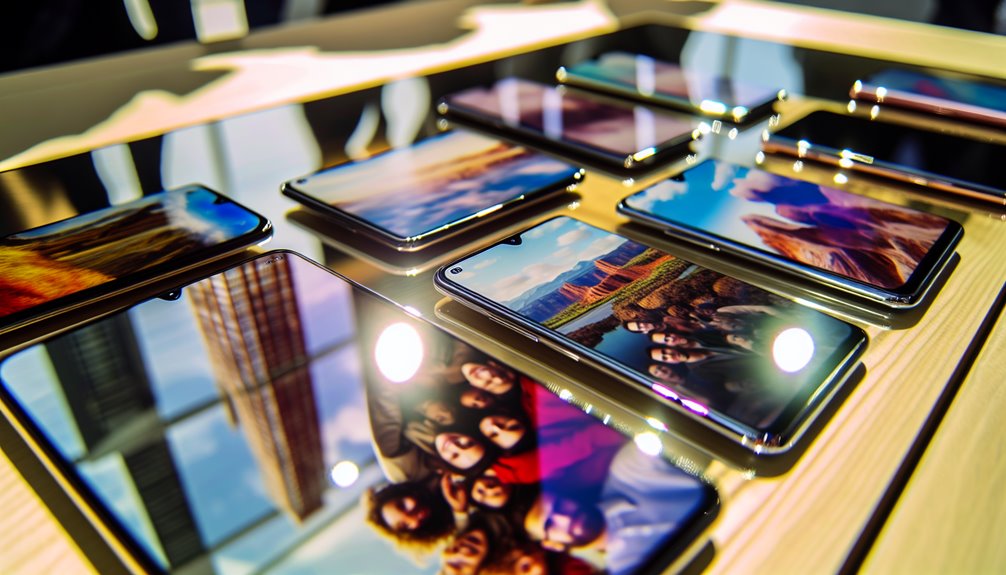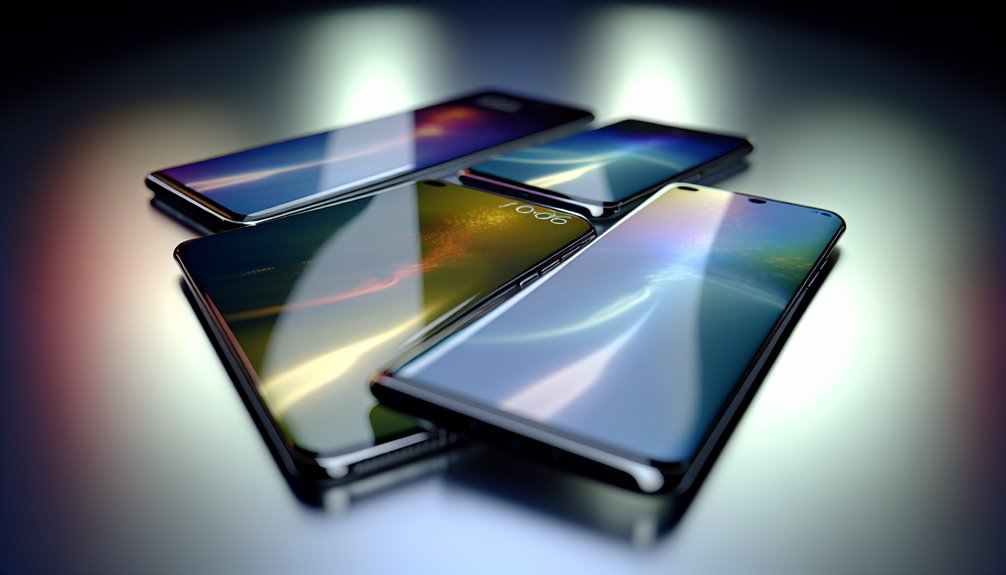Foldable phones are more than just a gimmick; they’re a significant trend in smartphone innovation. You get larger screens without sacrificing portability, allowing for an immersive experience. Their unique design enhances multitasking and gives you the versatility of a tablet in your pocket. While concerns about durability and a high price tag exist, consumer interest is growing, with sales projected to jump from 1.5M in 2020 to 20M by 2024. This evolving technology could reshape the future of smartphones. If you’re curious about what this means for the market, you’ll find plenty of insights ahead.
Key Takeaways
- Foldable phones are projected to grow significantly, with sales expected to rise from 1.5M in 2020 to 20M by 2024, indicating a strong trend.
- Innovative design and multitasking capabilities enhance user experience, making foldable phones practical for productivity and entertainment.
- Concerns about durability and app support remain, leading some to question their long-term viability as more than just a gimmick.
- Consumer interest is high, with 60% finding foldable phones intriguing, suggesting a potential market shift toward this technology.
- Ongoing advancements in display technology and increasing app optimization could solidify foldable phones’ status as a mainstream option in the future.
Overview of Foldable Phones
Foldable phones represent a significant shift in mobile technology, blending innovative design with practicality. As you explore this emerging trend, you’ll notice that the foldable design allows for larger screens without compromising portability. This means you can enjoy a more immersive experience when watching videos or multitasking, all while keeping your device compact enough to fit in your pocket.
One of the core appeals of foldable phones is user convenience. Imagine having the ability to switch from a phone to a tablet seamlessly, enhancing how you interact with apps and content. With the touch of a button, you can unfold your device to reveal a broader display, making it easier to read emails, browse the web, or engage in video calls.
Moreover, foldable phones often come with features that support this versatility, providing more than just a unique aesthetic. They aim to redefine how you use your smartphone daily, merging functionality with style. As you weigh the pros and cons of adopting this technology, consider how the foldable design might fit into your lifestyle, potentially transforming the way you communicate and consume information.
Key Features of Foldable Devices
When it comes to foldable devices, the display technology is a game changer that grabs your attention. You’ll notice how these innovations allow for vibrant visuals and seamless interactions, enhancing your overall experience. Plus, with multitasking capabilities ramped up, you can effortlessly juggle multiple apps, making productivity more accessible than ever.
Display Technology Innovations
Amid the rapid evolution of smartphone technology, display innovations play an essential role in defining the user experience of foldable devices. One of the standout features is the integration of OLED advancements, which allow for vibrant colors and deep blacks, enhancing your visual experience whether you’re using the device in tablet mode or folded up. The flexibility of OLED displays means they can bend without compromising picture quality, ensuring you get the best of both worlds.
Additionally, the use of flexible materials in the construction of these displays is vital. These materials not only make it possible to fold the screens but also contribute to their durability. Manufacturers are continuously improving the resilience of these screens against scratches and creases, addressing one of the primary concerns users have about foldable phones.
As a result, you’ll notice that the viewing experience remains consistent, no matter how you choose to use your device. With ongoing advancements in display technology, foldable phones are designed to adapt to your lifestyle, making them more than just a gimmick but rather a significant leap in smartphone evolution.
Multitasking Capabilities Enhanced
Multitasking is increasingly becoming a fundamental aspect of smartphone usage, and foldable devices excel in this arena. Their unique design enhances multitasking efficiency, allowing you to run multiple applications simultaneously without feeling cramped. The improved user interface on these devices makes switching between apps smoother and more intuitive.
Here are four key features that enhance multitasking capabilities:
- Split-Screen Functionality: You can display two apps side by side, making it easier to compare information or share content seamlessly.
- Floating Windows: Some foldable devices allow apps to float over others, enabling you to keep an eye on a chat while watching a video, for instance.
- Task Continuity: Foldable phones often support resuming tasks from where you left off, whether you’ve closed the app or switched screens.
- Enhanced Notifications: With larger displays, you can view notifications without interrupting your current activity, keeping you engaged and informed.
These features collectively enrich your smartphone experience, making foldable devices not just a trend, but a practical choice for those who prioritize multitasking.
Advantages of Foldable Phones
Foldable phones bring a unique blend of versatility and functionality that can enhance your mobile experience. These devices showcase remarkable design innovations, allowing you to shift effortlessly between a compact phone and a larger tablet-like display. This adaptability is perfect for multitaskers, letting you browse, watch, or create content more comfortably.
One of the standout features is the portability benefits. Traditional smartphones often compromise screen size for convenience, but foldable phones redefine this balance. When you fold a device, you get a larger screen without compromising on pocketability. This means you can carry a mini tablet in your bag or even your pocket, making it easier to stay productive on the go.
Furthermore, foldable phones often come equipped with advanced multitasking capabilities, allowing you to run multiple apps simultaneously. This is particularly advantageous for professionals and creatives who need to juggle responsibilities or brainstorm ideas while referencing other content.
Disadvantages and Concerns
While foldable phones offer innovation, they come with significant drawbacks that can’t be ignored. You’ll need to contemplate durability issues, as the flexible screens may not withstand daily wear and tear like traditional models. Plus, the high price tag and limited app support raise questions about whether these devices are worth the investment.
Durability Issues
One of the most significant concerns surrounding foldable phones is their durability, which many users find hard to ignore. While they offer innovative designs and functionalities, the technology behind these devices presents notable risks.
Here are four key durability issues to take into account:
- Flexible Materials: The screens are made of flexible materials that, while revolutionary, may not withstand daily wear and tear as well as traditional screens. Scratches and cracks can be more likely.
- Hinge Mechanisms: The hinges that allow the phone to fold are vital yet vulnerable components. Frequent opening and closing could lead to wear and potential failure over time.
- Water and Dust Resistance: Many foldable models lack robust water and dust resistance ratings, making them more susceptible to environmental factors.
- Longevity Concerns: As with any emerging technology, durability over the long term is uncertain. Users may worry about how these phones will hold up after extended use.
As foldable phones continue to evolve, addressing these durability issues will be essential for user confidence and widespread adoption.
High Price Tag
Durability concerns aren’t the only factors weighing on consumers’ minds when contemplating foldable phones; the high price tag associated with these devices is another significant drawback. You might be surprised to find that the cost of a foldable phone can exceed that of traditional flagship models by several hundred dollars. This high cost raises questions about whether the luxury appeal justifies the investment.
For many, the allure of owning a foldable phone lies in its innovative design and the promise of enhanced functionality. However, the reality is that this premium price often comes with compromises. You might find yourself wondering if the novelty will wear off, leaving you with a device that feels more like a status symbol than a practical tool.
Moreover, the potential for rapid depreciation looms large. As manufacturers continue to innovate, the initial investment might not hold its value for long. Ultimately, when weighing the benefits against the high price tag, it’s essential to reflect on what you truly value in a smartphone. Are you willing to spend the extra money for the luxury appeal, or would a more traditional device suffice?
Limited App Support
Maneuvering the landscape of foldable phones reveals a significant hurdle: limited app support. While these devices promise an innovative experience, you might find that not all apps take full advantage of their unique design. This is largely due to a lag in developer support for foldable technology, resulting in inconsistent app compatibility across platforms.
Here are some key concerns:
- Inconsistent User Experience: Many apps aren’t optimized for the larger screens, leading to a subpar experience.
- Limited Functionality: Some apps simply don’t function correctly when the device is unfolded, hampering usability.
- Fragmented Ecosystem: With various foldable models on the market, developers often struggle to cater to different screen sizes and resolutions.
- Slow Adoption: As foldables are still relatively new, it’ll take time for developers to adapt their apps, which may leave you waiting.
Market Trends and Sales Data
The smartphone landscape is shifting, and foldable phones are at the forefront of this transformation. You might be wondering whether these devices are merely a fad or if they truly represent significant market growth. Recent sales projections suggest that foldable phones are gaining traction, with an increasing number of consumers willing to invest in this innovative technology.
Here’s a quick look at the sales data for foldable phones:
| Year | Units Sold (millions) |
|---|---|
| 2020 | 1.5 |
| 2021 | 3.0 |
| 2022 | 7.0 |
| 2023 | 12.0 |
| 2024 (proj.) | 20.0 |
As you can see, the growth trajectory is impressive. In just a few years, foldable phone sales are expected to skyrocket, indicating a shift in consumer preferences. Analysts forecast a compound annual growth rate (CAGR) of over 40% for the next few years, driven by advancements in technology and increased availability of models. This trend suggests that foldable phones might indeed be more than just a gimmick, potentially reshaping the future of smartphones as we understand them.
Consumer Reception and Feedback
As you explore the world of foldable phones, you’ll find a mix of excitement and skepticism among users. Many appreciate the innovative design and multitasking capabilities, while others question the durability and practicality. Understanding this feedback is essential for evaluating market demand and the future of these devices.
User Experience Insights
Recent surveys indicate that around 60% of users find foldable phones intriguing, yet opinions about their practicality vary widely. User feedback reveals a mix of excitement and skepticism, particularly regarding usability challenges. You might be curious about what users are saying, so here are some key insights:
- Portability: Many appreciate the compact size when folded, making it easier to carry around.
- Multitasking: Users enjoy the ability to run multiple apps side by side, enhancing productivity on the go.
- Durability Concerns: Despite their innovative design, some users worry about the longevity of the folding mechanism and screen.
- Learning Curve: Adjusting to a foldable phone can be tricky; users often mention needing time to acclimate to the new interface and functionality.
Market Demand Analysis
Foldable phones have sparked a notable conversation in the tech world, with market demand reflecting a curious blend of enthusiasm and hesitation. As you explore consumer preferences, you might notice that while many users are excited about the innovative designs and multitasking capabilities, others remain skeptical about durability and price. This mixed reception is vital for understanding the evolving landscape of foldable technology.
Market forecasts indicate that while sales are projected to increase, growth may not be as rapid as initially anticipated. Consumers are grappling with whether the benefits of foldable phones outweigh the potential drawbacks. For some, the novelty and functionality are compelling, but for others, traditional smartphones still hold strong appeal due to their reliability and cost-effectiveness.
Feedback from early adopters highlights both excitement and caution. Those who embrace foldable phones often cite the unique user experience, while detractors point to concerns about long-term usability. Ultimately, the success of foldable phones will hinge on how manufacturers address these consumer concerns and adapt to market demands. As you consider the future, it’s clear that foldable phones are at a pivotal crossroads, poised between trend and gimmick.
Comparison With Traditional Smartphones
The rise of foldable phones has sparked a debate about their practicality compared to traditional smartphones, which have long dominated the market. While foldables offer a fresh take on design aesthetics, many users might be hesitant to change from their well-established habits. Here’s a breakdown of how these two categories compare:
- Size and Portability: Foldable phones can compact into smaller forms, making them easier to carry. However, traditional smartphones generally fit more comfortably in your hand.
- Durability: Traditional smartphones have a proven track record of resilience against everyday wear and tear. Foldables, on the other hand, may raise concerns about hinge durability and screen longevity.
- User Interface Experience: Foldable phones often provide a larger screen real estate, appealing to multitaskers. Yet, if you’re used to a traditional smartphone’s interface, the adjustment might feel awkward.
- Price Point: Foldables typically come with a premium price tag, while traditional smartphones offer a wider range of options that cater to various budgets.
Ultimately, evaluating design aesthetics and user habits will help you decide whether foldable phones are a genuine innovation or just a fleeting trend.
Major Brands and Their Models
As consumers weigh the pros and cons of foldable phones versus traditional smartphones, it’s important to contemplate which brands are leading the charge in this innovative space. Samsung models, like the Galaxy Z Fold series, have set a high bar with their impressive multitasking capabilities and large screens. Huawei devices, such as the Mate X series, showcase a unique outward-folding design that emphasizes portability.
Motorola innovations, particularly the Razr, tap into nostalgia while incorporating modern technology, making it a stylish option. Xiaomi designs, including the Mix Fold, focus on affordability without sacrificing quality. Oppo offerings, like the Find N, have made strides in compactness and usability, positioning themselves as serious contenders.
Meanwhile, LG experiments with foldable technology, though they’ve recently stepped back from the smartphone market. The Microsoft Surface Duo takes a different approach, emphasizing productivity with its dual-screen design. Asus concepts and Google plans hint at exciting future developments, while Apple rumors continue to swirl about their potential entry into foldable territory. Each brand brings a unique perspective, making the foldable phone landscape a dynamic area to watch as technology evolves.
Durability and Longevity Issues
Many users are understandably concerned about the durability and longevity of foldable phones, given their innovative designs and complex mechanisms. While these devices promise versatility, they also face significant design challenges that can affect their lifespan. Here are four key issues to take into account:
- Hinge Mechanism: The folding hinge is a critical component that can wear out over time, leading to potential failures in functionality.
- Screen Protection: Unlike traditional smartphones, foldable screens often use softer materials, making them more susceptible to scratches and damage.
- Water and Dust Resistance: Many foldable models lack the same level of water and dust resistance as their non-foldable counterparts, risking damage from everyday elements.
- Material Advancements: Manufacturers are experimenting with new materials to enhance durability, but not all innovations have proven effective in real-world conditions.
Understanding these factors can help you make an informed decision. While material advancements are promising, they still need to overcome the inherent challenges of foldable designs to guarantee longevity. Your investment in a foldable phone should evaluate these durability aspects carefully.
Future of Foldable Technology
With the rapid advancements in technology, the future of foldable devices appears both promising and complex. You might find yourself wondering how these innovations could reshape your daily tech experience. Foldable technology isn’t just about sleek designs; it’s about rethinking how you interact with your devices.
Future applications are likely to extend beyond smartphones. You could see foldable tablets that transform into larger screens for productivity or entertainment. Imagine a rollable display that fits in your pocket but expands for immersive gaming or video streaming. As these technologies mature, they could find their way into potential markets like automotive displays, wearables, and even smart home devices.
Moreover, as manufacturers continue to refine durability and usability, foldable devices could become more mainstream. You may soon find yourself choosing a foldable device for its versatility and enhanced functionality, rather than just aesthetics. The evolution of foldable technology will likely challenge traditional form factors, pushing boundaries in design and functionality. So, keep an eye out; the next wave of innovation could redefine how you use technology in your everyday life.
Price Comparison and Value
When considering the price of foldable phones, it is essential to weigh the cost against their unique features and capabilities. A proper cost analysis can help you determine if the investment aligns with your needs. Here are four key elements to assess when evaluating the value of foldable phones:
- Screen Real Estate: Foldable phones offer larger displays without increasing the device’s overall size, making multitasking and media consumption more enjoyable.
- Durability: Many models come with improved hinge technology and materials designed to withstand daily wear and tear, potentially extending the device’s lifespan.
- Performance: These devices often pack high-end processors and ample RAM, ensuring that they can handle demanding applications and multitasking seamlessly.
- Innovation Factor: Owning a foldable phone can position you at the forefront of technology, showcasing your willingness to embrace new trends.
Ultimately, your value assessment should reflect how these features align with your personal preferences and lifestyle. Consider whether the added benefits justify the premium price tag, or if you’d be just as satisfied with a traditional smartphone.
Expert Opinions and Predictions
How do experts view the future of foldable phones? According to expert insights, the consensus is cautiously optimistic. Many industry analysts believe that while foldable phones initially seemed like a gimmick, they’re now on the cusp of becoming a essential segment of the smartphone market. As manufacturers continue to refine technology, we can expect improved durability and user experience in upcoming models.
Industry forecasts suggest that by 2025, foldable devices could capture a significant share of the overall smartphone market. Experts point to innovations in materials, like ultra-thin glass, and advancements in hinge technology as critical factors in enhancing usability. They argue that as these devices become more robust and affordable, consumer acceptance will rise.
However, there are challenges. Market saturation and competition from traditional smartphones could hinder growth. Experts also caution that manufacturers must address concerns about software optimization to fully leverage the unique form factors of foldables. To summarize, while foldable phones may still face skepticism, expert opinions underscore a transformative potential that could reshape our interaction with technology in the coming years.
Frequently Asked Questions
How Do Foldable Phones Impact App Development and Compatibility?
Foldable phones introduce unique user interface challenges that app developers must navigate. You’ll need to take into account design challenges like adaptable layouts and flexible navigation to guarantee a seamless experience across varying screen sizes and orientations.
Are There Specific Accessories Designed for Foldable Phones?
Yes, there are specific accessories for foldable phones. You’ll find screen protectors tailored to their unique designs and battery cases that accommodate their distinct shapes, ensuring protection and extended usage without compromising functionality or style.
What Are the Environmental Impacts of Foldable Phone Production?
When considering the environmental impacts of foldable phone production, you’ll find sustainability concerns arise due to resource depletion. The materials used can strain ecosystems, urging a need for more eco-friendly manufacturing practices to mitigate these effects.
How Do Foldable Phones Affect Mobile Gaming Experiences?
Foldable phones enhance mobile gaming by offering multitasking capabilities and larger screens. You can easily switch between games and apps, enjoying a more immersive experience with improved visuals, making gameplay smoother and more enjoyable overall.
Can Foldable Phones Be Repaired Easily if Damaged?
Imagine a fragile butterfly, its wings delicate yet enchanting. Foldable phones can be tricky to repair; repair costs can soar due to durability concerns. You’ll want to weigh the beauty against the potential for damage.
Conclusion
In the domain of smartphones, foldable devices stand at a crossroads, balancing innovation and practicality like a tightrope walker. They offer a tantalizing glimpse into a future where versatility reigns, yet their durability and price tag cast shadows of doubt. As you ponder your next upgrade, consider whether the allure of flexibility outweighs the risks. In this unfolding narrative, only time will reveal if foldable phones are a fleeting trend or a transformative leap in mobile technology.






